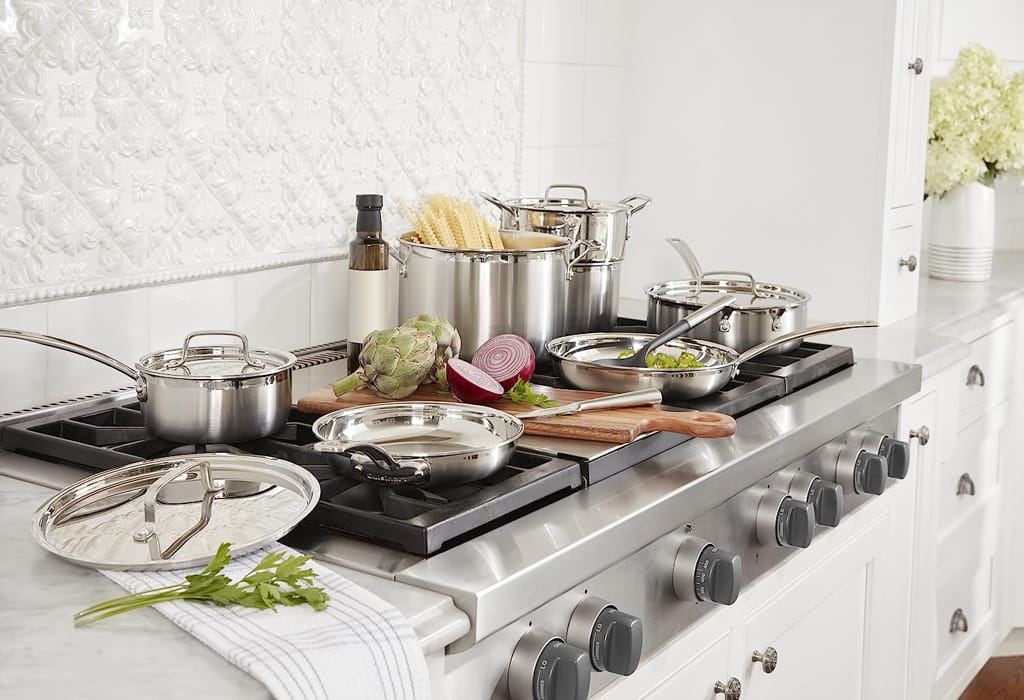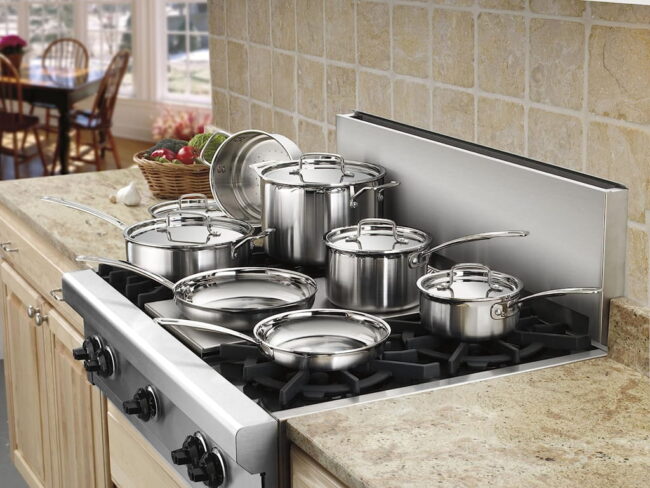A cookware that withstand the fury and wrath of kitchen gods? Check out this article to see why stainless steel is any chef’s soft spot!

This article is part of a series. Check them out all!
Stainless steel cookwares are the true workhorses of the kitchen. It is ideal for rapidly browning vegetables, meat or when a whole chicken needs pan-roasting, this type of skillet can easily become the pan of choice.
The importance of tri-ply construction (or more in case of five or seven), lies in the fact that stainless steel, though heavy and heat-retaining, is a slow conductor. Conversely, aluminum being lightweight, transfers heat quickly. Combining the two metals by sandwiching aluminum in the center results in a skillet that effectively retains heat for maximum browning. Furthermore, it evenly distributes heat across its entire surface, eliminating any hot and cold spots.
In commercial kitchens, stainless steel cookware, being fast, low-maintenance, and lighter than cast iron, remains popular. Particularly, those with a copper core heat up quickly and evenly, making them suitable for various cooking tasks, such as searing delicate meats and sautéing. Concerns about food sticking to the pan can be addressed by learning the correct cooking technique for stainless steel.
For home cooks, its low-maintenance requirements make it a perfect tool for any type of cooking. With its sturdiness, relatively light weight, and quick and even heating properties, it offers a versatile option for chefs. Tomato-based dishes and wine sauces, not recommended for a cast iron skillet, work well in a stainless steel pan. Additionally, stainless steel pans distribute heat more evenly, allowing for the searing of delicate meats like scallops after preheating the pan with a little oil.
When cladded, stainless steel heats up quickly, making it convenient for preparing fast meals. Its compatibility with all types of food, including acidic dishes, sets it apart from cast iron. Stainless steel can withstand temperatures of up to 500℉ (260℃), but it’s always advisable to check the cookware’s instructions for its specific temperature rating before using it in the oven.

Disadvantages of Stainless steel
- Learning curve
Cooking in stainless steel requires to learn the proper technique and experiment with cooking temperatures. - Limited usage
Many stainless steel cookware isn’t suitable for the oven so popping the skillet under the broiler for a quick roast or making bread in them isn’t really an option - Requires attention
Stainless steel doesn’t like to be heated up empty so making wraps, tortillas or skillet pizza isn’t really among its strengths - Prone to warping
Stainless steel cookware can warp under certain conditions (see below) - High price
Due to the intricate production processes stainless steel cookware commands a high price
Benefits of Stainless Steel
- Durability
Stainless steel cookware is highly durable and long-lasting. It is resistant to scratches, dents, and corrosion, making it suitable for daily use in busy kitchens. - Even Heating
Stainless steel is a good conductor of heat, ensuring even distribution of heat across the cooking surface. This prevents hot spots and helps to cook food evenly. - Non-Reactive
Stainless steel is non-reactive, meaning it does not react with acidic or alkaline foods. This makes it suitable for cooking a wide range of dishes, including those with tomato-based sauces or acidic ingredients. - Versatility
Stainless steel cookware is versatile and can be used on various heat sources, including gas, electric, induction, and even in the oven. Some stainless steel cookware is even dishwasher safe for easy cleaning. - Low Maintenance
Stainless steel is relatively easy to clean and maintain. It is dishwasher safe, and most stains and residue can be easily removed with regular washing. - Healthy Cooking
Stainless steel cookware is a healthy option as it does not leach any harmful chemicals or toxins into the food during cooking. - Professional Appearance
Stainless steel cookware has a sleek and professional appearance that looks great in any kitchen. - Does Not Retain Odors
Unlike some other types of cookware, stainless steel does not retain food odors after washing, ensuring that each dish you cook maintains its distinct flavors. - Longevity
With proper care, stainless steel cookware can last for a very long time, making it a worthwhile investment. - Compatibility
Stainless steel cookware is compatible with all types of utensils, including metal ones, without fear of damaging the cooking surface. - Heat Resistance
Stainless steel cookware can withstand high cooking temperatures, making it suitable for searing, browning, and high-heat cooking methods. - Hygienic
Stainless steel is easy to clean and sanitize, making it a hygienic option for cooking and food preparation.
Seasoning Stainless Steel
This is not a thing. The term “seasoning” a pan refers to the process of turning oil molecules into non-stick polymers that bound to the iron atoms in carbon steel or cast iron pan. Stainless steel, unlike carbon steel or cast iron, is a non reactive material. It can’t be seasoned.
Caring for Stainless Steel
Although stainless steel is undemanding it requires a certain level of care and attention to be a truly grateful part of our kitchen. While stainless steel is a durable and sturdy material, it is not immune to warping, especially when subjected to extreme heat or rapid temperature changes.
- High Heat
Exposing stainless steel cookware to very high heat, such as on a stove top burner set to maximum, can cause it to warp. This is more likely to happen with thinner or lower-quality stainless steel cookware. - Uneven Heating
Unevenly heating the cookware, such as heating an empty pan, can lead to warping. Always ensure that the heat is evenly distributed across the entire surface of the pan. - Rapid Temperature Changes
Suddenly subjecting hot stainless steel cookware to cold water or placing a hot pan on a cold surface can cause it to warp due to thermal shock. - Overheating in the Oven
Some stainless steel cookware especially those with a plastic handle, may not be suitable for extremely high temperatures in the oven. Always check the manufacturer’s guidelines for the recommended oven temperature. - Dropping or Impact
Dropping the cookware or subjecting it to strong impacts can also cause warping. - Uneven Weight Distribution
Storing heavy objects on top of stacked stainless steel cookware can potentially cause warping over time.
How to minimize the risk of warping
- Preheat the pan gradually and use medium to medium-high heat for most cooking tasks.
- Avoid empty pan preheating and always add some oil or food before heating the pan.
- Avoid sudden temperature changes. Allow the cookware to cool down naturally before washing it with cold water.
- Follow the manufacturer’s guidelines for oven-safe temperatures and care instructions.
- Store cookware carefully to avoid heavy objects being placed on top of it.

High-quality, thick-bottomed stainless steel cookware is less likely to warp compared to thinner or cheaper versions. Investing in well-made stainless steel cookware can you avoid warping and ensure long-lasting performance.
Cooking with Stainless Steel
To prevent food from sticking to stainless steel pans, there are three steps that needs to be taken.
- Preheat the pan
The most popular method to check if the pan has reached the correct temperature is the water droplet test. Sprinkle a few drops of water onto the preheated surface of the pan. If the pan is ready to be used, the water droplets will form into tight beads and dance around the surface of the pan. This is due to the Leidenfrost effect, where the water droplets form a temporary vapor barrier between the pan and the water, causing them to move around rather than immediately evaporating. - Add cooking oil
Once the pan is hot a thin layer of cooking oil need to be added, and the pan is ready to use. Another way to test if the pan is hot enough is to add a drop of water, which should make a “TSS” sound, split into multiple droplets, and evaporate. - Don’t overheat
There is such thing as too hot pan especially with induction or electric cook tops that heat distribution is much better than the gas stoves. If the skillet is too hot the surface of the food will burn before it has the chance to be released from the surface of the steel. There is no foolproof method to prevent this except starting at lower temperature and experimenting with our cook top and gear to find the perfect balance between temperature and speed. If a kitchen thermometer is available then the optimal range for searing is 400°F – 450°F / 204°C – 232°C.
Summary
- Stainless steel pans are versatile and suitable for most cooking tasks.
- Tri-ply (or more) construction allows for even heat distribution and retention.
- They are durable, easy to clean, and do not require seasoning.
- Proper techniques are needed to prevent food from sticking.
- Care should be taken to avoid warping, especially from high heat or sudden temperature changes.
Check out: